Last updated on May 13th, 2025 at 02:24 pm
The MGE Communication & Sales Seminars – 40.5 Total CE
You can now attend in-person or online!
Would you spend 9 days training to collect an extra $288,000 or more per year for the rest of your career?*
These dentists did it, why not you?

Don’t wait! Start increasing your practice collections today!
For more information, call 800-640-1140 or fill out the form below and an MGE team member will contact you shortly.
MGE Florida Office
St. Petersburg, FL
March 6-8, 2025
April 3-5, 2025
May 1-3, 2025
June 5-7, 2025
July 10-12, 2025
August 7-9, 2025
September 4-6, 2025
October 9-11, 2025
November 6-8, 2025
December 4-6, 2025
Thousands of dental professionals attend every year. Now’s your chance!
Objectives:
-
Understand what motivates patients
When you use the information for your case presentations, patients understand their treatment plans like they never have before, and begin to want the treatment they need. -
Improve communication with every patient.
These seminars teach you easy, effective methods to communicate with your patients and handle objections so they accept and pay for the treatment plans. -
Place the focus on doing what is best for the patient, not the insurance company.
No more feeling like insurance companies are dictating treatment. Applying these tools, you can begin doing more full treatment plans, making “phased” treatment plans to accommodate insurance coverage will become more and more of a thing of the past. To be frank, it can make you feel good to be a doctor again.
With all of this in place, collections rise, your patients are healthier, and the practice runs smoother.



“Before MGE I was stressed and worried constantly about how the practice would perform this month, the next month and so on. The MGE program gave me the control and certainty I needed as an executive. Scheduling and production are very organized, and everything runs efficiently.”
– Charmaine Johnson, DDS

“The MGE training made my office far more efficient. We are more productive in much less time than ever before. I have been able to add an associate and any problems or issues that arise throughout the day get dealt with quickly and effectively.”
– William Nerestant, DDS
Real Seminar Results
The average increase after 1 month is… 20% ($13,796) per month.
The average increase after 3 months is… 24% ($16,000) per month.
The average increase after 12 months is… 36% ($24, 448) per month.
These numbers are based off a study taken from 127 randomly selected dental practice owners who attended the ABC seminars between 2015 and 2018.
What will you learn at these seminars?
Here are some of the highlights:
- How to address and overcome patients’ questions or concerns about treatment
- How to help the patient go beyond “just what the insurance covers” when they need further treatment
- Why every person reacts differently and how to connect with each personality type so your presentation will resonate with them
- What makes the diagnosis land home in a person’s mind – so they truly understand why they need the treatment and how important it is?
- Working enough time into the schedule for case presentations and consultations
- Uncovering the true barrier to accepting treatment (it’s usually not actually the money)
- Presenting treatment options so that the patient opts for the ideal treatment plan
- Using visual aids to make the diagnosis and ramifications more real to the patient
- Getting the patient on your side to help overcome barriers together and work out financial arrangements, rather than you just talking at them and trying to convince them
- Evaluating where the patient is at in the sales process and what you need to do to get them closed doing the full treatment they need
- How the whole team can contribute to case acceptance and treatment plan completions
- The best way to do the “hand off” from the Doctor to the Financial/Treatment Coordinator
- Guidelines for making solid financial arrangements and/or accepting payment prior to scheduling treatment
- The morning huddle: identifying patients with outstanding treatment and case presentation opportunities before the day starts, so everyone is coordinated and can plan intelligently to make production targets
- Crafting the perfect patient experience in your office, from the first time they pick up the phone through the exam and starting treatment.
- Tools to communicate effectively with patients and team members
- And MUCH more!
Not convinced yet?
There’s a reason thousands of industry leading dentists have attended these seminars. Hear what they have to say:
About the Seminars
Who not to sell to: While this may sound strange (learning who not to sell to at a sales seminar), this information is extremely powerful. We’ll show you how to identify and handle what we call the “Problem Patient,” in most cases before a bur ever touches a tooth. While some patients are easy to manage and others can be difficult, some (a small percentage) can create havoc in your practice and make your job seem unrewarding. The “Problem Patient” comes in all shapes and sizes and can be from any socioeconomic background. They all do however, share very specific characteristics which you’ll learn at Seminar A.
“De-Stressing” Case presentations: How to take the stress and discomfort out of the case presentation process, including the financial discussion (regardless of the size of the case): We’ll show you how to stay focused and comfortable during the “sales process.” You won’t be afraid of or uncomfortable about selling (or the financial discussion) by applying this information.
Case Presentations – The Right Attitude: Start off on the wrong foot and your case presentation can go south – very fast. What starts as a large treatment plan ends up with a patient “just doing what insurance pays,” if anything. This can get so bad that some doctors don’t even present a full treatment plan fearing that the patient will become upset. By maintaining the proper attitude and addressing the case with your patient the right way, you’ll present, and patients will begin to accept full treatment plans – regardless of insurance coverage.
Different Types of People (Patients): People are different. We’ve all known that on some levels all of our lives. But, if this is the case, how can you communicate effectively with anyone who walks through your door? Twenty percent of the patients who walk in are easy to handle. Twenty percent can be trouble (see Seminar A). This means sixty percent (the majority) may not be the easiest to manage – but they can all be turned into great patients. Learn how to identify, communicate with and manage different types of patients to turn them into long-term patients who follow through with treatment.
The Sales Process: Everyone, we repeat, everyone goes through, in sequence, five very specific phases when buying a service or product. This may be fast or it may be slow. Chances are you’ve had patients on the cusp of going ahead with their treatment, only to give up and let them walk out the door. Find out how to identify these phases and which “phase” a patient is in while you’re presenting a case. We’ll also show you how to move them through this process and go ahead with treatment.
Objections: Discover how to assist your patients to overcome barriers and objections to paying for and starting treatment.
The Source of Sales Failure: Learn the source of sales failure (and how to avoid it).
Maintaining an Environment that Promotes Success: One of the biggest problems with any seminar is the “high” afterwards followed by the eventual “sag” of non-application. We’ll show you what causes this and how to avoid it, along with how to maintain an upbeat, professional, successful environment in your office that makes coming to work (for you and your staff) fun and productive.
Communication: Communication is the cornerstone of human relations. It’s also the most important component in the sales process. It also happens to be one of the most misunderstood subjects you can find anywhere! Find out what communication really is and how to truly “connect” with your patients (or anyone for that matter). Learn the formula to excellent, effective, professional communication – that gets results!
Treatment Options: Options are a part of any treatment discussion with a patient. At the same time, we’d all prefer that patients accept the option that’s best for both their clinical and personal situation. Find out how to discuss options so that patients select the one that best fits their situation – as opposed to the cheapest one available.
Patient Finances: “I can’t afford it,” is a common enough objection. Especially in these more challenged economic times. However, in a majority of cases a patient will say this regardless of whether it’s true or not. They will then turn around and buy something (like an expensive handbag) that doesn’t positively impact their dental health. Many dentists find this quite frustrating. Learn how to handle the financial discussion with patients so that they make the best choice for their health.
Practice Income: Learn the basic rule that determines practice income.
The Four Steps of Selling: We present the four basic steps of presenting a treatment plan from start to finish. Ultimately, it’s up to your patient to decide whether they’re going to go through with a treatment plan. Using these steps, you’ll be able to really “reach” your patients and get them truly motivated, resolute and committed (i.e., financially) about pursuing needed treatment.

MGE Management Experts Inc. Nationally Approved PACE Program Provider for FAGD/MAGD credit. Approval does not imply acceptance by any regulatory authority or AGD endorsement. 04/01/2024 to 03/31/2027 Provider ID# 305927
Don’t wait! Start increasing your practice collections today!
For more information, call 800-640-1140 or fill out the form below and an MGE team member will contact you shortly.
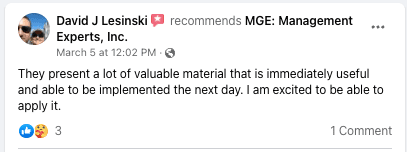
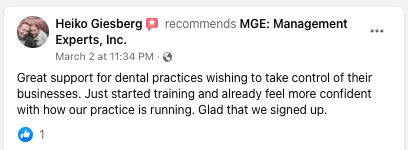
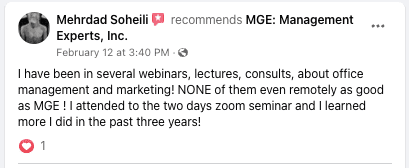
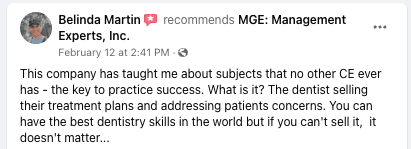

"By the time I finished all three of the MGE Communications & Sales Seminars, collections had nearly doubled!" — CS, DDS

"I love it, because not only am I doing more of the dentistry I love, but my patients are making the best decision for their health and are very happy as a result. The first seminar spurred the largest increase in collections I'd ever had. I saw an increase of 250% within one month!" — TL, DDS

"Every time we went to an MGE Communications & Sales seminar, production would go up immediately when we got back to the office. I mean every time we went to MGE. After doing these seminars I can see that my communication with patients is much better. I'm much more focused and able to see where my patients are coming from and how I can get through to them." — DD, DDS

"I now know how to explain treatment in such a way that patients truly understand. I also learned how to effectively address any questions, concerns and objections they might have. As a result of the MGE Communication & Sales Seminars, our treatment acceptance rate is much better, and we've increased by 55% per month in collections." — NP, DDS

"We did the MGE Communication & Sales Seminars in late 2014 and were in awe; this was stuff we weren't hearing anywhere else in the industry. Our collections increased by 50% per month! It was like they had been inside our practice and knew all the little things we struggled with, exactly how patients behaved, and everything that we know, deep down, needs to change but nobody talks about." — RS, DDS & VS, DDS

"The MGE Communication & Sales Seminars were an absolute wealth of material. We applied what we learned and it worked! Case acceptance improved and my confidence soared! Because I’m able to better communicate with my patients, more of them fully understand and accept treatment. My drive and purpose increased. I’m fully focused on im-proving somebody’s health; I’m giving them more years, giving their teeth more years." — MO, DDS

"The seminars gave me the tools I needed to focus on what mattered: the patient getting the treatment they needed. The seminars gave me the ability to comfortably present full treatment plans and get them accepted; without worrying about insurance coverage or finances. The month following just our first MGE Communication & Sales Seminar, our production and collections went up by over 60%!" — AV, DDS & MS, DDS
* Results may vary from client to client, especially depending on the client’s degree of dedication to positive change. As such, no particular result can be promised or guaranteed to any client. The testimonials and information on this page are not a guarantee of results of any kind. MGE: Management Experts, Inc., hereby expressly disclaims any and all warranties expressed and implied, including without limitation all implied warranties of merchantability and fitness for a particular purpose.
Don’t wait! Start increasing your practice collections today!
For more information, call 800-640-1140 or fill out the form below and an MGE team member will contact you shortly.
* Results may vary from client to client, especially depending on the client’s degree of dedication to positive change. As such, no particular result can be promised or guaranteed to any client. The testimonials and information on this page are not a guarantee of results of any kind. MGE: Management Experts, Inc., hereby expressly disclaims any and all warranties expressed and implied, including without limitation all implied warranties of merchantability and fitness for a particular purpose.

About MGE:
Management Experts
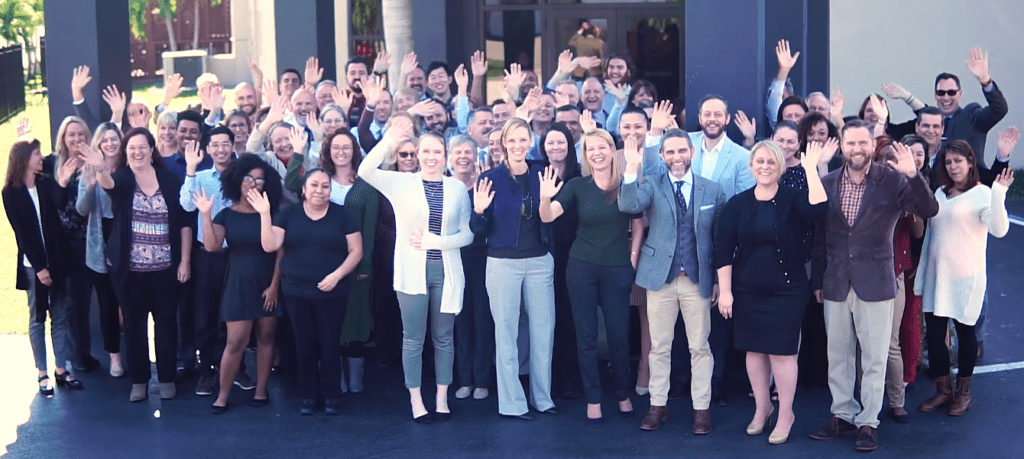
Headquartered in St. Petersburg, Florida with a satellite office in Anaheim, California, MGE provides practice management education and coaching to dentists, dental specialists and their teams. For over twenty years we’ve taught tens of thousands of dentists how to stimulate growth, implement reliable management systems and increase profitability in their practices.
Decades of experience with the dental profession combined with a fierce diligence to stay on the cutting edge of industry trends, has made MGE the “go-to” solution for thousands of dental professionals looking for the freshest and most effective practice building strategies available. Backing this up, MGE clients’ practices grow at a rate beyond any other group in the industry.
MGE clients can be found in 48 US states and 4 Canadian provinces. Our team boasts over 50 staff, including an elite team of consultants, management trainers and service personnel ready to service our client’s needs, both in person and online.